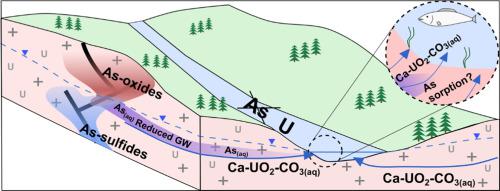当前位置:
X-MOL 学术
›
J. Geochem. Explor.
›
论文详情
Our official English website, www.x-mol.net, welcomes your
feedback! (Note: you will need to create a separate account there.)
Release of geogenic uranium and arsenic results in water-quality impacts in a subarctic permafrost region of granitic and metamorphic geology
Journal of Geochemical Exploration ( IF 3.4 ) Pub Date : 2020-10-01 , DOI: 10.1016/j.gexplo.2020.106607 Elliott K. Skierszkan , John W. Dockrey , K. Ulrich Mayer , Roger D. Beckie
Journal of Geochemical Exploration ( IF 3.4 ) Pub Date : 2020-10-01 , DOI: 10.1016/j.gexplo.2020.106607 Elliott K. Skierszkan , John W. Dockrey , K. Ulrich Mayer , Roger D. Beckie

|
Abstract This study investigates geogenic U and As mobilization in relation to bedrock geology, groundwater geochemistry, and the presence of mineral deposits in the Dawson Range, Yukon, Canada, a remote subarctic region that has drawn recent interest from mining industry. For this study we compiled and interpreted a geochemical dataset from the region that includes 1075 rock samples, 365 sediment samples, 3189 surface water samples, and 384 groundwater samples. Elevated concentrations of U and As occur through natural weathering processes. Median U concentrations exceed the Canadian guideline for the protection of aquatic life of 15 μg/L (long-term exposure) at 8% of 547 surface-water monitoring locations and the maximum observed concentration is 337 μg/L. 39% of monitoring wells have median groundwater U concentrations above this guideline and the maximum observed concentration is 589 μg/L. Uranium mobilization is driven by weathering of granitic and metamorphic bedrock that has contents near or slightly above the average upper crustal abundance of 2.7 μg/g and by formation of soluble calcium-carbonato-uranyl complexes in groundwater. Arsenic is more heterogeneously distributed in rock than U, with localized enrichment occurring near sulfide-mineral bearing ore deposits. While >2000 μg/L As is observed present in chemically reduced groundwater, As attenuation is also observed through sorption onto Fe-(oxyhydr)oxides. Despite the occurrence of As-rich groundwater, surface-water As concentrations are consistently low (
中文翻译:

地质成因铀和砷的释放对花岗岩和变质地质亚北极永久冻土区的水质产生影响
摘要 本研究调查了与基岩地质学、地下水地球化学以及加拿大育空地区道森山脉矿床存在相关的地质成因 U 和 As 迁移,该地区是最近引起采矿业兴趣的偏远亚北极地区。在本研究中,我们编译并解释了该地区的地球化学数据集,其中包括 1075 个岩石样本、365 个沉积物样本、3189 个地表水样本和 384 个地下水样本。U 和 As 的浓度升高是通过自然风化过程发生的。在 547 个地表水监测点的 8% 中,U 浓度中值超过了加拿大保护水生生物指南 15 微克/升(长期接触),观察到的最大浓度为 337 微克/升。39% 的监测井的地下水 U 浓度中值高于该准则,观察到的最大浓度为 589 μg/L。铀的流动是由花岗岩和变质基岩的风化作用驱动的,这些基岩的含量接近或略高于平均上地壳丰度 2.7 μg/g,以及地下水中可溶性钙-碳酸-铀酰复合物的形成。砷在岩石中的分布比 U 更不均匀,局部富集发生在含硫化物矿物的矿床附近。虽然在化学还原的地下水中观察到 >2000 μg/L 的 As,但通过吸附到 Fe-(羟基)氧化物上也观察到 As 衰减。尽管存在富含 As 的地下水,但地表水中的 As 浓度始终很低(铀的流动是由花岗岩和变质基岩的风化驱动的,这些基岩的含量接近或略高于平均上地壳丰度 2.7 μg/g,以及地下水中可溶性钙-碳酸-铀酰复合物的形成。砷在岩石中的分布比 U 更不均匀,局部富集发生在含硫化物矿物的矿床附近。虽然在化学还原的地下水中观察到 >2000 μg/L 的 As,但通过吸附到 Fe-(羟基)氧化物上也观察到 As 衰减。尽管存在富含 As 的地下水,但地表水中的 As 浓度始终很低(铀的流动是由花岗岩和变质基岩的风化驱动的,这些基岩的含量接近或略高于平均上地壳丰度 2.7 μg/g,以及地下水中可溶性钙-碳酸-铀酰复合物的形成。砷在岩石中的分布比 U 更不均匀,局部富集发生在含硫化物矿物的矿床附近。虽然在化学还原的地下水中观察到 >2000 μg/L 的 As,但通过吸附到 Fe-(羟基)氧化物上也观察到 As 衰减。尽管存在富含 As 的地下水,但地表水中的 As 浓度始终很低(砷在岩石中的分布比 U 更不均匀,局部富集发生在含硫化物矿物的矿床附近。虽然在化学还原的地下水中观察到 >2000 μg/L 的 As,但通过吸附到 Fe-(羟基)氧化物上也观察到 As 衰减。尽管存在富含 As 的地下水,但地表水中的 As 浓度始终很低(砷在岩石中的分布比 U 更不均匀,局部富集发生在含硫化物矿物的矿床附近。虽然在化学还原的地下水中观察到 >2000 μg/L 的 As,但通过吸附到 Fe-(羟基)氧化物上也观察到 As 衰减。尽管存在富含 As 的地下水,但地表水中的 As 浓度始终很低(
更新日期:2020-10-01
中文翻译:

地质成因铀和砷的释放对花岗岩和变质地质亚北极永久冻土区的水质产生影响
摘要 本研究调查了与基岩地质学、地下水地球化学以及加拿大育空地区道森山脉矿床存在相关的地质成因 U 和 As 迁移,该地区是最近引起采矿业兴趣的偏远亚北极地区。在本研究中,我们编译并解释了该地区的地球化学数据集,其中包括 1075 个岩石样本、365 个沉积物样本、3189 个地表水样本和 384 个地下水样本。U 和 As 的浓度升高是通过自然风化过程发生的。在 547 个地表水监测点的 8% 中,U 浓度中值超过了加拿大保护水生生物指南 15 微克/升(长期接触),观察到的最大浓度为 337 微克/升。39% 的监测井的地下水 U 浓度中值高于该准则,观察到的最大浓度为 589 μg/L。铀的流动是由花岗岩和变质基岩的风化作用驱动的,这些基岩的含量接近或略高于平均上地壳丰度 2.7 μg/g,以及地下水中可溶性钙-碳酸-铀酰复合物的形成。砷在岩石中的分布比 U 更不均匀,局部富集发生在含硫化物矿物的矿床附近。虽然在化学还原的地下水中观察到 >2000 μg/L 的 As,但通过吸附到 Fe-(羟基)氧化物上也观察到 As 衰减。尽管存在富含 As 的地下水,但地表水中的 As 浓度始终很低(铀的流动是由花岗岩和变质基岩的风化驱动的,这些基岩的含量接近或略高于平均上地壳丰度 2.7 μg/g,以及地下水中可溶性钙-碳酸-铀酰复合物的形成。砷在岩石中的分布比 U 更不均匀,局部富集发生在含硫化物矿物的矿床附近。虽然在化学还原的地下水中观察到 >2000 μg/L 的 As,但通过吸附到 Fe-(羟基)氧化物上也观察到 As 衰减。尽管存在富含 As 的地下水,但地表水中的 As 浓度始终很低(铀的流动是由花岗岩和变质基岩的风化驱动的,这些基岩的含量接近或略高于平均上地壳丰度 2.7 μg/g,以及地下水中可溶性钙-碳酸-铀酰复合物的形成。砷在岩石中的分布比 U 更不均匀,局部富集发生在含硫化物矿物的矿床附近。虽然在化学还原的地下水中观察到 >2000 μg/L 的 As,但通过吸附到 Fe-(羟基)氧化物上也观察到 As 衰减。尽管存在富含 As 的地下水,但地表水中的 As 浓度始终很低(砷在岩石中的分布比 U 更不均匀,局部富集发生在含硫化物矿物的矿床附近。虽然在化学还原的地下水中观察到 >2000 μg/L 的 As,但通过吸附到 Fe-(羟基)氧化物上也观察到 As 衰减。尽管存在富含 As 的地下水,但地表水中的 As 浓度始终很低(砷在岩石中的分布比 U 更不均匀,局部富集发生在含硫化物矿物的矿床附近。虽然在化学还原的地下水中观察到 >2000 μg/L 的 As,但通过吸附到 Fe-(羟基)氧化物上也观察到 As 衰减。尽管存在富含 As 的地下水,但地表水中的 As 浓度始终很低(









































 京公网安备 11010802027423号
京公网安备 11010802027423号